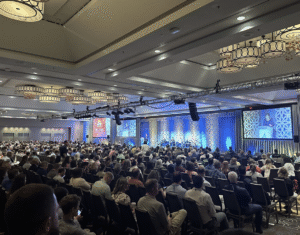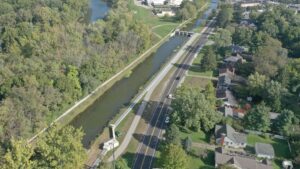Why Does The FloodBreak Passive Flood Barrier Float?
The FloodBreak passive flood barrier is actually a buoyant panel constructed of hollow aluminum extrusions. The extrusions are designed to be structural while also providing excellent flotation. Additionally, the extrusions are chambered so that even if an area of the panel is compromised, the overall panel will still float. This is similar to the design of a ship’s hull, where bulkheads protect the ship even if the hull is locally damaged.
As the floodwater fills the gate pan, the hydrostatic pressure lifts the flood barrier and continues to raise it as the floodwater continues to rise. The buoyant flood barrier floats on top of the water. There is no need for human intervention or power to deploy the FloodBreak Automatic Floodgate.
See How It Works
How Much Does The Floating Panel Weigh?
The actual weight varies depending on the type of gate, size and any special coatings or surface treatments specified. We design the cross-section of the gate panel to ensure that the total weight is always less than the water it floats upon and include a factor of safety to ensure this. Every floodgate is certified by an independent professional engineer who ensures that the floodgate is designed to successfully deploy.
Passive Flood Protection: Frequently Asked Questions
The FloodBreak flood barrier is designed to automatically float up, so all that is needed is floodwaters to pool under the buoyant hinged panel and the hydrostatic pressure will deploy the gates without human intervention.
The FloodBreak automatic floodgate is actually a buoyant panel constructed of hollow aluminum extrusions. The extrusions are designed to be structural while also providing excellent flotation. Additionally, the extrusions are chambered so that even if an area of the panel is compromised, the overall panel will still float. This is similar to the design of a ship’s hull, where bulkheads protect the ship even if the hull is locally damaged.
Absolutely. Placing the floodgate on an incline or decline has no negative bearing on the function of the FloodBreak flood control system. We have installed FloodBreak flood barriers on minor inclines and in cambered roadways. The geometry of an installation almost never prohibits use of our system. We’d be happy to discuss your project.
The FloodBreak passive flood barrier system will operate normally with silt and clay suspended in the floodwater. It doesn’t impact the operation – even very muddy water will float the bouyant flood barrier. The system is designed so that debris is washed through to the pan and out the drainage pipes, including during rainstorms and other non-flood water events. Contact us to discuss the specifics on your project.



